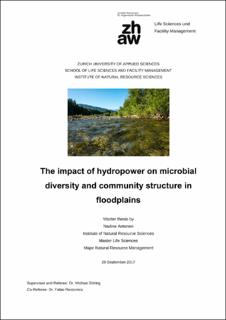Please use this identifier to cite or link to this item:
https://doi.org/10.21256/zhaw-4800| Publication type: | Master thesis |
| Title: | The impact of hydropower on microbial diversity and community structure in floodplains |
| Authors: | Antenen, Nadine |
| Advisors / Reviewers: | Döring, Michael Rezzonico, Fabio |
| DOI: | 10.21256/zhaw-4800 |
| Extent: | 46 |
| Issue Date: | 2017 |
| Publisher / Ed. Institution: | ZHAW Zürcher Hochschule für Angewandte Wissenschaften |
| Language: | English |
| Subjects: | Habitat heterogenity; T-RFLP; Residual flow; Hydropeaking |
| Subject (DDC): | 333: Economics of land and resources 577: Ecology |
| Abstract: | Within freshwater ecosystems, floodplains are among the most diverse ecosystems on earth but the increasing human demand for water, energy and food resulted in a decrease of biodiversity. Even though hydropower is often seen as “green energy”, it creates several negative impacts on riverine systems. In order to produce energy, river water is abstracted and released, leading to hydropeaking and residual flow sections, both representing a major disturbance on the natural functions and dynamics of a river. The ecological impact of hydropower production on riverine systems has been extensively investigated, however, mostly focusing on structural aspects. The present study focused on the microbial diversity and community structure in three hydrologically different floodplain sections, two impacted by hydropower and one in a natural reference system. Abiotic characteristics of habitats and genetic fingerprinting (T-RFLP) of the microbial communities were used to assess differences and similarities between and within these regimes. Within the latters we investigated sediments of seven different floodplain habitat types over a sampling period of one and a half year (summer 2015 until autumn 2016) consisting of six sampling seasons. Six abiotic parameters (temperature, water content, total organic matter, total nitrogen, total carbon and grain size distribution) were used to analyse patterns amongst habitats, regimes and seasons. Organic matter, water content, total nitrogen and total carbon content showed significant differences between the habitats whereas of the regimes the hydropeaking showed relevant influences on abiotic factors. Furthermore, we could illustrate several relationships between abiotic factors and microbial diversity, mainly within the same habitats and regimes as the distinct abiotic properties were highlighted. While the microbial communities clearly differ between aquatic and terrestrial habitats as well as between seasons, there are little differences among the regimes. Linking abiotic characteristics, shaped by the hydrological regimes, to microbial diversity and community structure allows the consideration of the latter as possible indicators of disturbances in river systems. The use of the genetic fingerprinting technique (T-RFLP) proved to be an appropriate method to gain first insights into patterns of microbial diversity and communities. In this context, the results from this study are a first contribution towards assessments of disturbances by microbial diversity and community analysis and possibly to a future development of a functional indicator for disturbance. |
| URI: | https://digitalcollection.zhaw.ch/handle/11475/1877 |
| License (according to publishing contract): | Not specified |
| Departement: | Life Sciences and Facility Management |
| Appears in collections: | Masterarbeiten Life Sciences |
Files in This Item:
| File | Description | Size | Format | |
|---|---|---|---|---|
| 2017_Antenen_Nadine_MA_MScLS_NRS.pdf | 1.97 MB | Adobe PDF |  View/Open |
Show full item record
Antenen, N. (2017). The impact of hydropower on microbial diversity and community structure in floodplains [Master’s thesis, ZHAW Zürcher Hochschule für Angewandte Wissenschaften]. https://doi.org/10.21256/zhaw-4800
Antenen, N. (2017) The impact of hydropower on microbial diversity and community structure in floodplains. Master’s thesis. ZHAW Zürcher Hochschule für Angewandte Wissenschaften. Available at: https://doi.org/10.21256/zhaw-4800.
N. Antenen, “The impact of hydropower on microbial diversity and community structure in floodplains,” Master’s thesis, ZHAW Zürcher Hochschule für Angewandte Wissenschaften, 2017. doi: 10.21256/zhaw-4800.
ANTENEN, Nadine, 2017. The impact of hydropower on microbial diversity and community structure in floodplains. Master’s thesis. ZHAW Zürcher Hochschule für Angewandte Wissenschaften
Antenen, Nadine. 2017. “The Impact of Hydropower on Microbial Diversity and Community Structure in Floodplains.” Master’s thesis, ZHAW Zürcher Hochschule für Angewandte Wissenschaften. https://doi.org/10.21256/zhaw-4800.
Antenen, Nadine. The Impact of Hydropower on Microbial Diversity and Community Structure in Floodplains. ZHAW Zürcher Hochschule für Angewandte Wissenschaften, 2017, https://doi.org/10.21256/zhaw-4800.
Items in DSpace are protected by copyright, with all rights reserved, unless otherwise indicated.